Residential Construction: Concrete Footings, Hydraulic Services, Load Bearing Walls, Scaffold Systems
Added on 2023-06-13
21 Pages4697 Words236 Views
Residential Construction 1
Residential Construction
Assignment 2
BLAR11050
Term 1 2018
Due Date: May 4 2018
Weighting: 30%
Residential Construction
Assignment 2
BLAR11050
Term 1 2018
Due Date: May 4 2018
Weighting: 30%
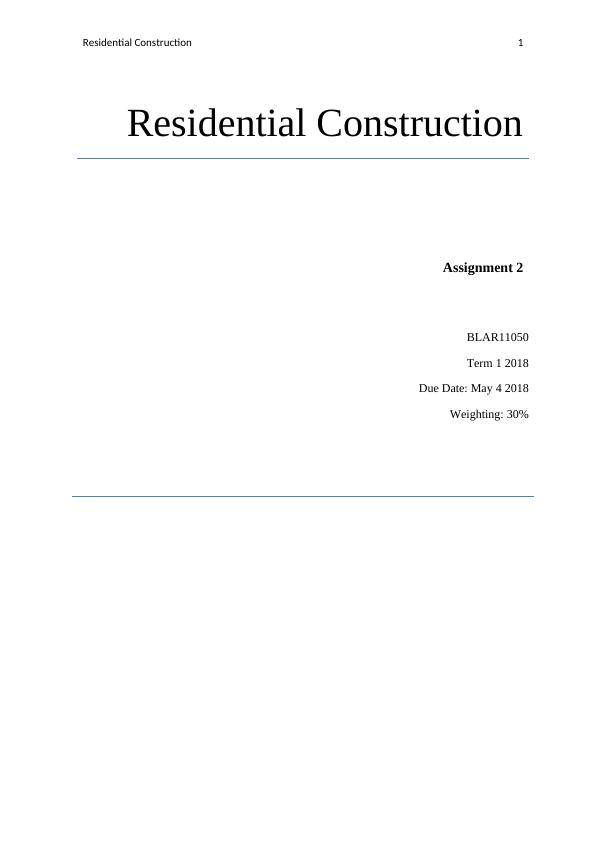
Residential Construction 2
Table of Contents
Introduction..............................................................................................................................................2
Question 1:...............................................................................................................................................3
Question 2:...............................................................................................................................................9
Question 3:.............................................................................................................................................14
Conclusion:............................................................................................................................................17
References..............................................................................................................................................18
Table of Contents
Introduction..............................................................................................................................................2
Question 1:...............................................................................................................................................3
Question 2:...............................................................................................................................................9
Question 3:.............................................................................................................................................14
Conclusion:............................................................................................................................................17
References..............................................................................................................................................18

Residential Construction 3
Introduction
A class 1a type of development is defined as a single dwelling unit which is detached from
other buildings, or a unitary house which is detached from others by use of a fire resistant
wall. They can either be villa units, town houses, terrace houses or row houses.
The houses are constituted of several structural members from footings, foundations, columns
beams and slab decks. In this assignment, one such project was identified and the elements
discussed herein are concrete footings, hydraulic services, doors and windows and load
bearing walls.
Introduction
A class 1a type of development is defined as a single dwelling unit which is detached from
other buildings, or a unitary house which is detached from others by use of a fire resistant
wall. They can either be villa units, town houses, terrace houses or row houses.
The houses are constituted of several structural members from footings, foundations, columns
beams and slab decks. In this assignment, one such project was identified and the elements
discussed herein are concrete footings, hydraulic services, doors and windows and load
bearing walls.
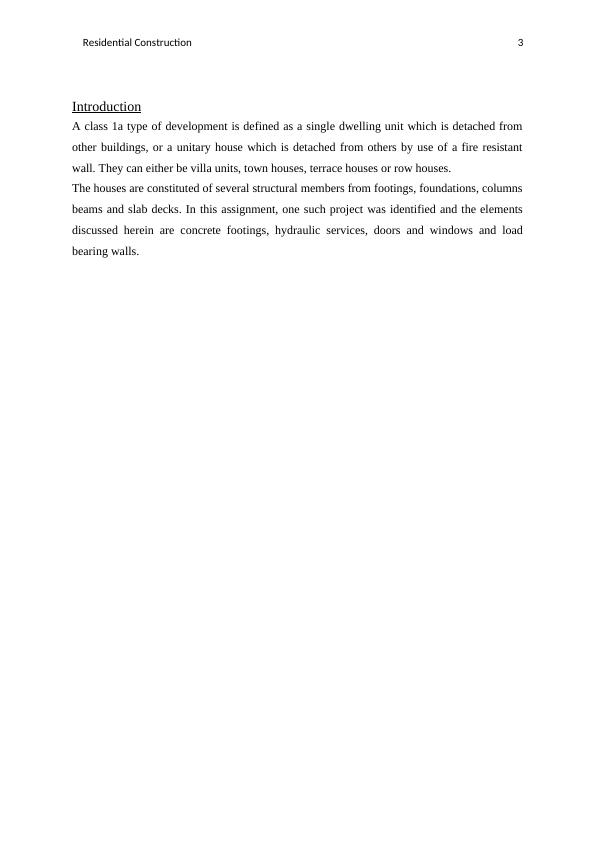
Residential Construction 4
Question 1:
Concrete footings
Concrete footings are structural elements that are used to transfer loads from a building to the
foundation. There are different types of footings such as spread footing, strip footing (also
called wall footing), and combined footing.
Spread footing is a footing that has a column in the middle of the footing. The force acting
downward from the load bearing column is spread on the soil by the spread footing. The
bottom of the spread footing is in tension. The tension arises from the bending moment due to
the downward force caused by the column and the earth resistance. Engineers usually design
the spread footings according to the load computations that the footings are expected to carry
from the supporting column (De Larrard, 2014). The design results give the reinforcement
that will be used in the construction of the footing. Since concrete is weak in tension, the
design of footings will always yield a reinforcement of the bottom part of the spread footing
to support the columns and dissipate loads to the soil.
Strip footing are footings that have a continuous wall above them. The footings are utilized to
distribute the forces acting through the wall to the ground (Cajka, et al., 2014).
Combined footings are concrete spread footings that are under multiple columns. The layout
of this footing may vary widely depending on the locations of the columns and the loads they
carry. The design of combined footings yields reinforcement on both the bottom and top parts
of the footing because of the effect of the column forces on the footing. A bending moment
diagram is used to indicate the critical areas for reinforcement (Janulíková & Marie , 2013).
Relevant standards
AS 2870 – 1996 has the codes that govern the construction of residential slabs and footings.
Assembly sequence
The placing of concrete is an activity that has to be preceded by some others. Excavation of
the foundation trench needs to have been done using a Backhoe. Depending on the elevation
of the building pad elevation, it may be necessary to have formwork for the footing. The
reinforcement bar to be used is placed such that there is a clearance from the earth. This is
done by having spacer blocks between the reinforcement and the earth. The rebar is also fixed
in position by tying them using s particular gauge of rods. This is done to ensure that the
Question 1:
Concrete footings
Concrete footings are structural elements that are used to transfer loads from a building to the
foundation. There are different types of footings such as spread footing, strip footing (also
called wall footing), and combined footing.
Spread footing is a footing that has a column in the middle of the footing. The force acting
downward from the load bearing column is spread on the soil by the spread footing. The
bottom of the spread footing is in tension. The tension arises from the bending moment due to
the downward force caused by the column and the earth resistance. Engineers usually design
the spread footings according to the load computations that the footings are expected to carry
from the supporting column (De Larrard, 2014). The design results give the reinforcement
that will be used in the construction of the footing. Since concrete is weak in tension, the
design of footings will always yield a reinforcement of the bottom part of the spread footing
to support the columns and dissipate loads to the soil.
Strip footing are footings that have a continuous wall above them. The footings are utilized to
distribute the forces acting through the wall to the ground (Cajka, et al., 2014).
Combined footings are concrete spread footings that are under multiple columns. The layout
of this footing may vary widely depending on the locations of the columns and the loads they
carry. The design of combined footings yields reinforcement on both the bottom and top parts
of the footing because of the effect of the column forces on the footing. A bending moment
diagram is used to indicate the critical areas for reinforcement (Janulíková & Marie , 2013).
Relevant standards
AS 2870 – 1996 has the codes that govern the construction of residential slabs and footings.
Assembly sequence
The placing of concrete is an activity that has to be preceded by some others. Excavation of
the foundation trench needs to have been done using a Backhoe. Depending on the elevation
of the building pad elevation, it may be necessary to have formwork for the footing. The
reinforcement bar to be used is placed such that there is a clearance from the earth. This is
done by having spacer blocks between the reinforcement and the earth. The rebar is also fixed
in position by tying them using s particular gauge of rods. This is done to ensure that the
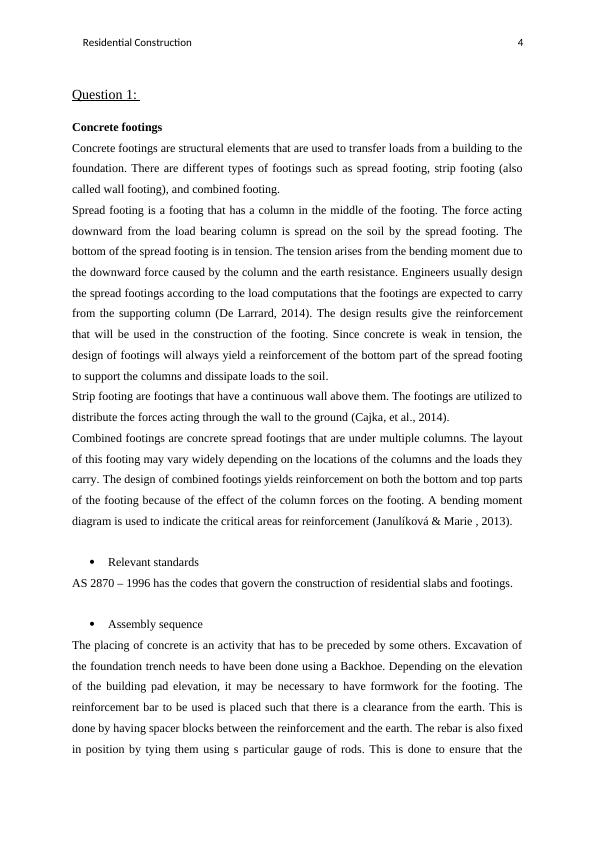
Residential Construction 5
rebar do not move while the concrete is being placed. The rebar needs to be at specific
locations before, during and after placing of concrete (Ghali, et al., 2014).
The prevailing project circumstances may make the concrete placing procedure to vary. A
ready mix concrete truck can be used to place the concrete by running along the footing
trench and chute concrete directly into the footings. Wheelbarrows can also be used to carry
concrete from the truck to the footing. Concrete pumps could also be used to transport
concrete to the foundations (Al-Ansari, 2017).
Hydraulic services
The water corporation, the National Construction Corporation (NCC) and the Department of
Fire and Emergency services (DFES) all outline the scope of hydraulic works to be done in
construction projects. These works are; sanitary plumbing, property sewer, supply of water
and fire services and drainage of stormwater.
Before any works can commence, all permits are required to be submitted to the relevant
authority. The key considerations to be looked into are the water quality to be used, health
and safety of the building and its users, availability of material, ease of maintenance and the
design life of the material (Karcher, et al., Mar 2018).
The requirements for a class 1A type of structure for hydraulic services are as follows; the
mains water must have a filtering and conditioning unit. The use of water is monitored by the
use of an installed meter. Flow restrictions are installed in taps in addition to having leak
detection systems. Electric point-of-use hot water are normally installed to the specification
of a building. Generally chrome plated valves, or high performance mixing valves are
recommended for hot water units. Internal wet rooms are usually installed with floor wastes
or gullies and bucket traps. The floor is usually graded to the specifications of the approved
design. It is not necessary to install puddle flanges on the ground level, but all other floor
areas including balconies are needed (Wu, et al., 2014).
According to Australian standards, box gutters are required to have the same area as the
downpipes.
Plumbing fixtures or tapware are usually installed after completion of tiling works using a
specified sealant. Pans and cisterns, urinals, hand basins, taps and showers are fitted to the
requirement of the specification documents.
A contractor is required to avail samples of the above named units, which he is intending to
supply, for client approval prior to eventual supply and fixing of the same.
rebar do not move while the concrete is being placed. The rebar needs to be at specific
locations before, during and after placing of concrete (Ghali, et al., 2014).
The prevailing project circumstances may make the concrete placing procedure to vary. A
ready mix concrete truck can be used to place the concrete by running along the footing
trench and chute concrete directly into the footings. Wheelbarrows can also be used to carry
concrete from the truck to the footing. Concrete pumps could also be used to transport
concrete to the foundations (Al-Ansari, 2017).
Hydraulic services
The water corporation, the National Construction Corporation (NCC) and the Department of
Fire and Emergency services (DFES) all outline the scope of hydraulic works to be done in
construction projects. These works are; sanitary plumbing, property sewer, supply of water
and fire services and drainage of stormwater.
Before any works can commence, all permits are required to be submitted to the relevant
authority. The key considerations to be looked into are the water quality to be used, health
and safety of the building and its users, availability of material, ease of maintenance and the
design life of the material (Karcher, et al., Mar 2018).
The requirements for a class 1A type of structure for hydraulic services are as follows; the
mains water must have a filtering and conditioning unit. The use of water is monitored by the
use of an installed meter. Flow restrictions are installed in taps in addition to having leak
detection systems. Electric point-of-use hot water are normally installed to the specification
of a building. Generally chrome plated valves, or high performance mixing valves are
recommended for hot water units. Internal wet rooms are usually installed with floor wastes
or gullies and bucket traps. The floor is usually graded to the specifications of the approved
design. It is not necessary to install puddle flanges on the ground level, but all other floor
areas including balconies are needed (Wu, et al., 2014).
According to Australian standards, box gutters are required to have the same area as the
downpipes.
Plumbing fixtures or tapware are usually installed after completion of tiling works using a
specified sealant. Pans and cisterns, urinals, hand basins, taps and showers are fitted to the
requirement of the specification documents.
A contractor is required to avail samples of the above named units, which he is intending to
supply, for client approval prior to eventual supply and fixing of the same.
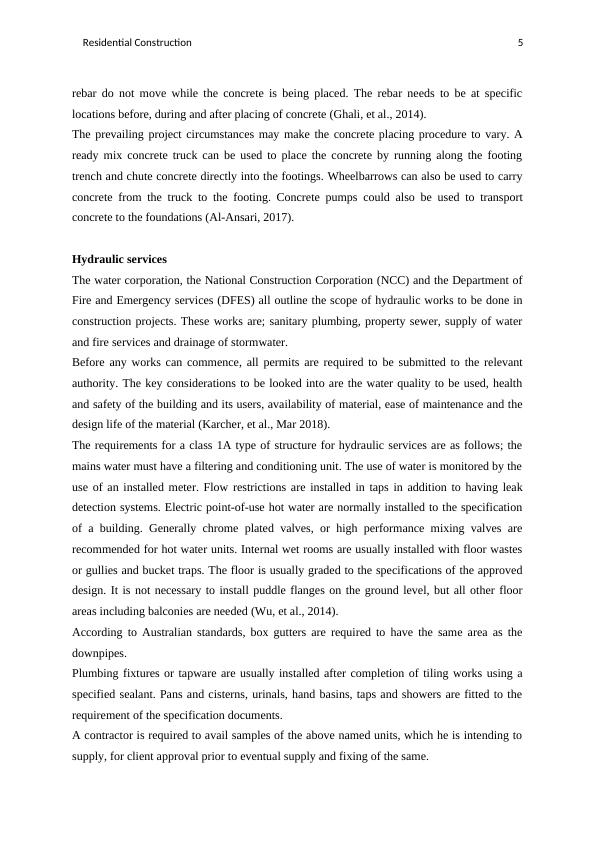
Residential Construction 6
Relevant standards
The following Australian Standards are used for the design of hydraulic services in Class 1a
constructions.
AS/NZS 3500.1 – Plumbing and drainage; water services
AS/NZS 3500.2 – Plumbing and drainage; sanitary plumbing and drainage
AS/NZS 3500.3 – Plumbing and drainage; stormwater drainage
AS/NZS 3500.4 – Plumbing and drainage; heated water services
AS/NZS 5601 – Gas Installations
AS 1345 – Identification of the contents of pipes, conduits and ducts.
AS/NZS 1546.1 – On-site waste management treatment units, Septic tanks
Assembly sequence
Sanitary plumbing fixtures include; wastewater connections and fittings, and all trims and
traps. Their installation must comply with AS/NZS 3500.2 – Plumbing and drainage; sanitary
plumbing and drainage.
Just before installation, all components are visually inspected for likely contamination and
damage. The fittings are then lubricated at the threads before assembly. The installations are
initially done hand – tight. This is because the installation must be checked for tubing of
mating hose assembly (Best, et al., 2015). Proper alignment of fittings can also be achieved
through this.
Tightening of the fixtures is carried out by the following methods
Specified torque method
Flats from finger tight method
Materials required
Hydraulic services are usually made of aluminium, brass, cast iron and stainless steel
material. The range of materials produced are;
Hydraulic pipes
Hydraulic tubes
Hydraulic hose
Fittings such as compression fittings, crimps, end fittings, flanges, push to connect
and threaded fittings
Relevant standards
The following Australian Standards are used for the design of hydraulic services in Class 1a
constructions.
AS/NZS 3500.1 – Plumbing and drainage; water services
AS/NZS 3500.2 – Plumbing and drainage; sanitary plumbing and drainage
AS/NZS 3500.3 – Plumbing and drainage; stormwater drainage
AS/NZS 3500.4 – Plumbing and drainage; heated water services
AS/NZS 5601 – Gas Installations
AS 1345 – Identification of the contents of pipes, conduits and ducts.
AS/NZS 1546.1 – On-site waste management treatment units, Septic tanks
Assembly sequence
Sanitary plumbing fixtures include; wastewater connections and fittings, and all trims and
traps. Their installation must comply with AS/NZS 3500.2 – Plumbing and drainage; sanitary
plumbing and drainage.
Just before installation, all components are visually inspected for likely contamination and
damage. The fittings are then lubricated at the threads before assembly. The installations are
initially done hand – tight. This is because the installation must be checked for tubing of
mating hose assembly (Best, et al., 2015). Proper alignment of fittings can also be achieved
through this.
Tightening of the fixtures is carried out by the following methods
Specified torque method
Flats from finger tight method
Materials required
Hydraulic services are usually made of aluminium, brass, cast iron and stainless steel
material. The range of materials produced are;
Hydraulic pipes
Hydraulic tubes
Hydraulic hose
Fittings such as compression fittings, crimps, end fittings, flanges, push to connect
and threaded fittings
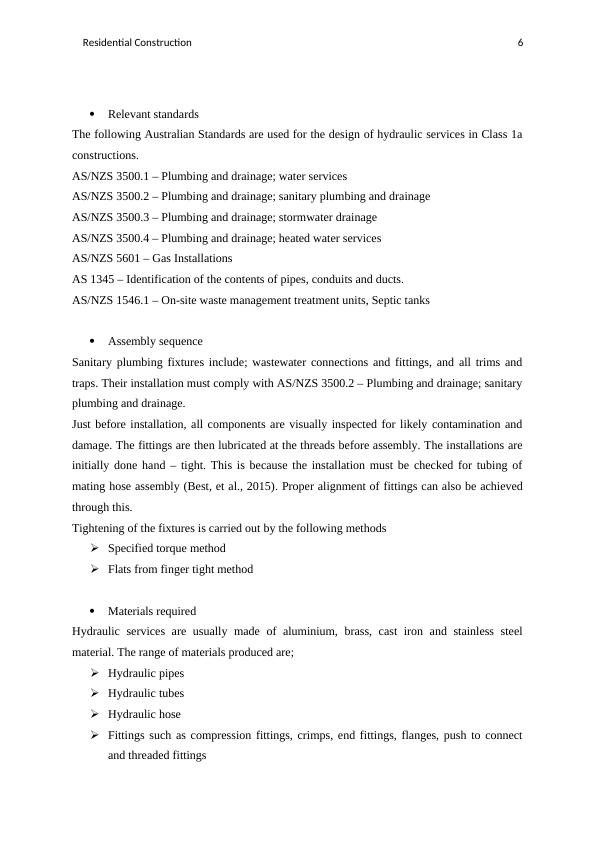
End of preview
Want to access all the pages? Upload your documents or become a member.
Related Documents
Combined pad Foundation Assessment 2023lg...
|20
|2074
|15
Sittingbourne Footing System Assignmentlg...
|27
|1880
|48
Relationship Of The Ratio Between Longer to Shorter Spanlg...
|13
|1946
|21
CPCCBC4011B: Assessment 4 - Footing, Retaining Wall, Structural, Floor, Wall, Roof, Services, Fire Prevention, Qualitylg...
|9
|843
|328
Building Systems and Structural Connections for a Middle Rise Buildinglg...
|11
|1147
|450
Reinforced Concrete Design: Components, Load Combinations, and Slab Typeslg...
|21
|4641
|323